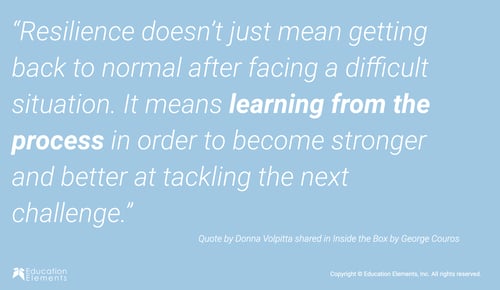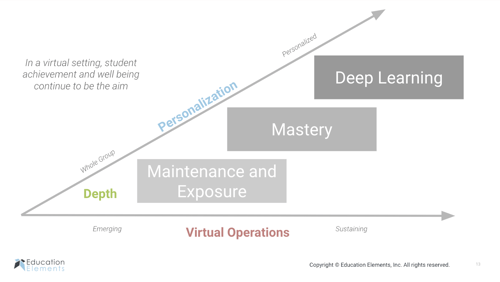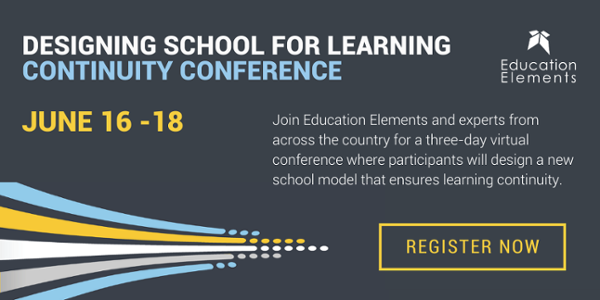
"Resilience doesn’t just mean getting back to normal after facing a difficult situation. It means learning from the process in order to become stronger and better at tackling the next challenge.”
– Quote by Donna Volpitta shared in Inside the Box by George Couros
A little more than a month ago, school teams transitioned to distance learning arguably overnight. In doing so, we quickly saw the cracks in our school systems, such as equity, access, social-emotional learning, and experiences that empower students to be more self-directed. Now more than ever we need to learn from the process of shifting remotely, so we become stronger and better at addressing the cracks in the system that are being exacerbated by this pandemic. Otherwise, what was it all for?
Whether your district is just maintaining contact or wanting to transform the learning experience, it is important to remember that clarity around what we are hiring distance learning to do will better support stakeholders now and in the future. Student achievement and well-being remain the intention of learning. Three questions that districts + schools might consider as they move learning forward:
-
How will individual students' academic and SEL needs be understood and met?
-
How deeply will students learn new skills + concepts?
-
What resources, routines, and procedures are in place to support distance learning?
The answers to these questions can be categorized into one of the three Dimensions of Distance Learning and will help you honor where you are today, support you with where you want to be next week, and empower you as you strategize how you want to transform learning and sustain post-COVID-19
The Three Dimensions of Distance Learning
-
Personalization: Student choice and ownership, flexible content, targeted instruction, data to drive instruction
-
Depth of Knowledge: Learning experiences intentionally designed to facilitate mastery + deeper learning (ie. DOK or Bloom’s)
-
Distance Operations: Schedule, attendance, and grading procedures, requesting assistance, submitting work, developing teacher capacity

Here are districts transforming the student experience across the three dimensions of distance learning.
Putnam County School System (TN) - Personalization
Since 2010, teachers in Putnam County School System have been implementing personalized learning in classrooms to better meet the needs of students. As Putnam County shifted to distance learning, they have found success in the ways teachers are leveraging personalizing learning for students. Ashley, an Instructional Coach and Interventionist at Northeast Elementary School and one of the Elementary Personalized Learning (PL) Team Leads for the district, responsible for supporting PL implementation across elementary schools, utilizes digital platforms that allow students to record responses in their own time instead of in front of the “class” on Zoom. When designing lessons for distance learning, she considers the needs and learning preferences of her students. She knows it is important for her students to feel comfortable and supported. With their recorded responses, Ashley is able to hear any misconceptions and provide feedback. For Ashley, risk-taking is a vital part of implementing personalized learning and now more than ever she values the importance of modeling new ways to engage and learn for her district and school teams, as well as for her students.
Broward County Public Schools (FL) - Virtual Operations
Broward County Public Schools in Florida, one of the largest school districts in the country, has been implementing personalized learning since 2018. Their Innovative Learning department provides regular, tailored professional development on how to meaningfully integrate technology to increase student engagement and mastery. As Broward shifted to distance learning, they leveraged the strength of this team and their existing technology plans to quickly set expectations and put support in place for all teachers. Instructional Technology Facilitators helped build capacity in teachers using Canvas, their LMS, to communicate regularly with students, post lesson materials, and facilitate learning. Facilitators made Canvas support modules available and highlighted technology tools teachers could use to enhance student engagement. Additionally, the district is using web conferencing (through Microsoft Teams) as a way for teachers and students to engage with each other and offer a semblance of normality that otherwise would not be possible. District leadership feels fortunate about their investment in infrastructure, hardware, and software–as it is playing an enormous role in facilitating continued teaching and learning.
Klein Independent School District (TX) - Depth of Learning
Klein ISD, a medium-sized district in Texas, was on spring break when the news about school closures broke. The district team worked quickly to make a plan for device deployment and leveraged their instructional officers and digital specialists to think through their vision for instruction. A key component of Klein’s vision is to “know every student by name, strength, and need.” They continued this vision when thinking about what they’re hiring distance learning to do. Building on their experience with Education Element’s SEPAD method, they structured lesson plans to include a Spark, Expand, Practice, Apply, and Debrief. With approximately 54,000 students engaging in distance learning, this framework for remote lessons prioritized hooking students, going deeper with content, and empowering students to practice and apply learning at rigorous levels. At Mahaffey Elementary, one of Klein’s inaugural personalized learning campuses, principal Holly Mason shared how teachers are using breakout features of video calls to facilitate targeted instruction. By staying true to their vision, Klein is able to provide a depth of learning for students.
If resilience means learning from the process, we at Education Elements hope this process teaches us more about how to develop greater authentic self-direction, opportunities for family engagement, and prime conditions for creative solutions. By focusing on the Three Dimensions of Distance Learning, we can reach our goals for students now and create sustainable plans for the future.
To learn more about the Three Dimensions of Distance Learning, see our First 20 Days of Virtual Learning resources. Also explore our guide on How to Design a Responsive Return Plan as schools and districts explore distance learning and teaching as a long-term solution to the transformed education landscape.




